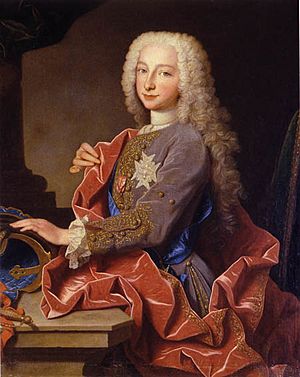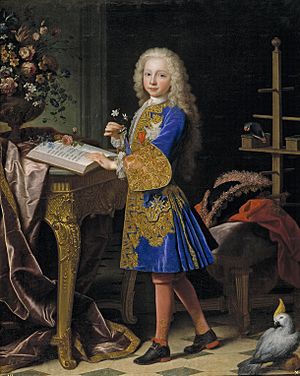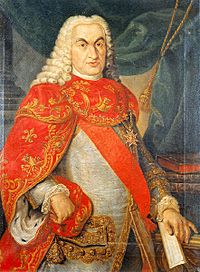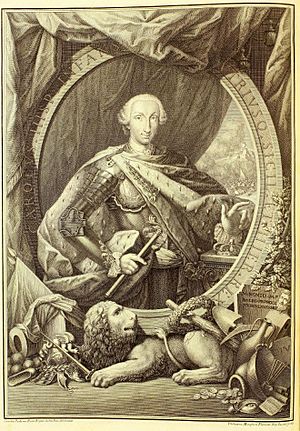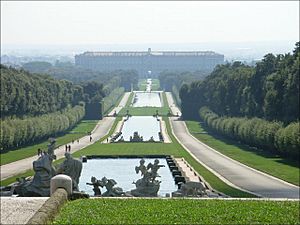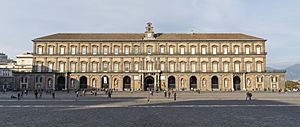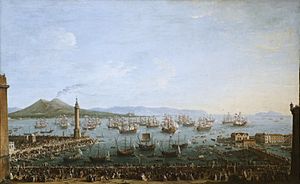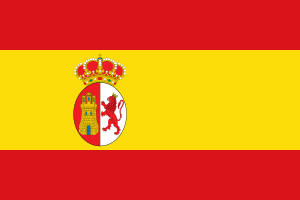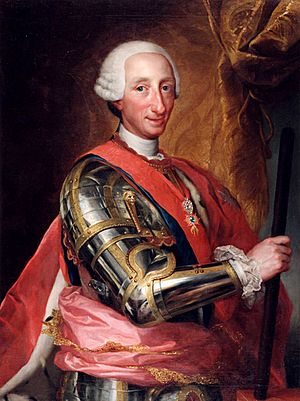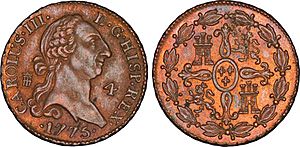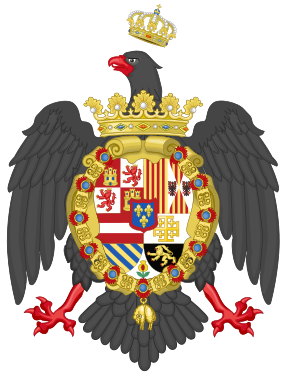Charles III of Spain facts for kids
Quick facts for kids Charles III |
|||||
|---|---|---|---|---|---|
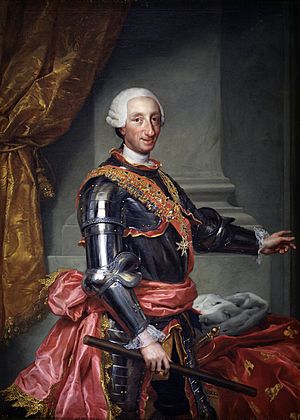
Portrait by Anton Raphael Mengs, c. 1761
|
|||||
| King of Spain (more...) | |||||
| Reign | 10 August 1759 – 14 December 1788 | ||||
| Predecessor | Ferdinand VI | ||||
| Successor | Charles IV | ||||
| Regent | Elisabeth Farnese (1759 – 1760) | ||||
| Chief Ministers | |||||
| King of Naples and Sicily | |||||
| Reign | 3 July 1735 – 6 October 1759 | ||||
| Coronation | 3 July 1735, Palermo Cathedral | ||||
| Predecessor | Charles VI & IV | ||||
| Successor | Ferdinand IV & III | ||||
| Duke of Parma and Piacenza | |||||
| Reign | 26 February 1731 – 3 October 1735 | ||||
| Predecessor | Antonio Farnese | ||||
| Successor | Charles I | ||||
| Born | 20 January 1716 Royal Alcazar of Madrid, Spain |
||||
| Died | 14 December 1788 (aged 72) Royal Palace of Madrid, Spain |
||||
| Burial | El Escorial | ||||
| Spouse | |||||
| Issue Detail |
|
||||
|
|||||
| House | Bourbon-Anjou | ||||
| Father | Philip V of Spain | ||||
| Mother | Elisabeth Farnese | ||||
| Religion | Roman Catholicism | ||||
| Signature |  |
||||
Charles III (born 20 January 1716 – died 14 December 1788) was the King of Spain from 1759 to 1788. Before that, he was the Duke of Parma and Piacenza (1731–1735). He also ruled as King of Naples and King of Sicily (1734–1759).
Charles was the fifth son of Philip V of Spain. His mother was Philip's second wife, Elisabeth Farnese. Charles believed in a type of rule called enlightened absolutism. This meant he was an absolute ruler, but he used new ideas from the Enlightenment to improve his country. He also supported regalism, which meant increasing the power of the state over the Church.
In 1731, when he was 15, Charles became the Duke of Parma and Piacenza. In 1734, at 18, he led Spanish troops to take over the Kingdom of Naples and Kingdom of Sicily. In 1738, he married Maria Amalia of Saxony, a smart and cultured princess. They had 13 children, and eight lived to adulthood. Charles ruled in Italy for 25 years, gaining valuable experience before becoming King of Spain.
He became King of Spain in 1759 after his half-brother Ferdinand VI died without children. As King of Spain, Charles III made many important changes, known as the Bourbon Reforms. He wanted to bring more money to the crown and protect the Spanish Empire. He made trade easier, improved farming, and supported science and universities. He also reduced the Church's power and even expelled the Jesuits from the Spanish Empire. He made the Spanish army and navy stronger. Many of his reforms helped the country grow and increased the king's power.
Historians like Stanley Payne and John Lynch say that Charles was one of the most successful rulers of his time. He was a strong, smart leader who chose good ministers.
Contents
Spain's Imperial History
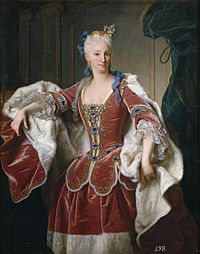
In 1713, the Treaty of Utrecht ended the War of the Spanish Succession. This treaty greatly reduced Spain's power. The House of Bourbon had ruled Spain since 1700. Under the treaty, Spain kept its lands in America and the Philippines. But it gave up territories in Europe, like the Southern Netherlands and parts of Italy, to other powers. Great Britain gained the islands of Menorca and Gibraltar.
Charles's father, Philip V of Spain, became King of Spain in 1700. He spent his reign trying to get back the lands Spain had lost in Europe. In 1714, after his first wife died, Philip married the ambitious Elisabeth Farnese. She quickly became a strong influence on the king.
On January 20, 1716, Charles was born in Madrid. He was fourth in line to the Spanish throne. Elisabeth Farnese wanted Charles to rule his own lands. She aimed for him to inherit the duchies of Parma and Piacenza in Italy. She also hoped he would get the Grand Duchy of Tuscany.
Charles's Early Life
Charles's birth led to big plans for Spain in Europe. In 1717, Spain invaded Sardinia and then Sicily. This led to the War of the Quadruple Alliance. After the war, the Treaty of The Hague of 1720 recognized Charles as the heir to Parma and Piacenza.
Charles's half-brother died in 1719, making Charles third in line for the Spanish throne. Spain tried to arrange marriages with France to improve relations. Charles was even engaged to a French princess for a time.
Later, his mother, Elisabeth Farnese, looked to Austria for a bride. She proposed Charles marry Maria Theresa of Austria, the future Holy Roman Empress. This alliance was signed in 1725. However, a war between Spain and Britain stopped these marriage plans.
The Treaty of Seville in 1729 allowed Charles to take Parma, Piacenza, and Tuscany if needed. In 1731, the Duke of Parma died without an heir. The Second Treaty of Vienna officially recognized Charles as the Duke of Parma and Piacenza. Since he was still young, his grandmother, Dorothea Sophie of Neuburg, became his regent.
Ruling in Italy
Becoming Duke of Parma
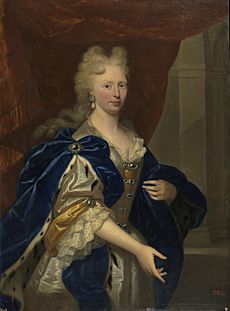
Charles left Spain in October 1731 and traveled to Italy. He arrived in Livorno in December 1731. He visited his cousin, the Grand Duke of Tuscany, who welcomed him warmly. Charles even got sick with smallpox on his way to Florence. In Florence, he was named the "Hereditary Prince of Tuscany."
When the Holy Roman Emperor heard about this, he was angry. He felt that only he could name the heir to Tuscany. Charles then moved to Parma in October 1732. The people of Parma welcomed him with celebrations.
Taking Naples and Sicily
In 1733, a war started over who would be King of Poland. France, Spain, and Savoy allied against Austria and Russia. Charles's mother saw this as a chance to get back the Kingdoms of Naples and Sicily for Spain.
On January 20, 1734, Charles turned 18 and became old enough to rule on his own. He was also made commander of all Spanish troops in Italy. On February 27, King Philip declared his plan to capture Naples. Charles led the army towards Naples in March.
The Austrians were already fighting in other parts of Italy. Many nobles in Naples wanted Charles to rule. On March 9, the Spanish took two islands in the Bay of Naples. A week later, they won a sea battle against the Austrians. By March 31, Charles's army surrounded Naples. The Austrians had to retreat.
Charles and his troops entered Naples. The city welcomed him, and he received the keys to the city. The Spanish quickly captured the Austrian-held fortresses in Naples. This happened even though Charles had no military experience.
Becoming King of Naples and Sicily
Charles made a grand entrance into Naples on May 10, 1734. He rode through the city, and people threw money to the crowds. He went to the Cathedral of Naples for a blessing. Charles moved into the Royal Palace. He was the first ruler of Naples in two centuries to actually live there.
His father, King Philip V, wrote to him, calling him "To the King of Naples, My Son, and My Brother." This showed Charles was now a recognized king.
The Austrians sent more troops to Naples. But Spanish troops attacked them on May 25, 1734, at Bitonto, winning a big victory. To celebrate, Naples was lit up for three nights.
After taking more towns, the last Austrian strongholds were Gaeta and Capua. Charles watched the Siege of Gaeta, which ended on August 6. Spanish troops then went to Sicily and conquered the island by early 1735. Capua fell in November 1734. The people of Naples were happy to be independent from the Austrians.
In 1735, Charles officially gave Parma to the Holy Roman Emperor. In return, the Emperor recognized Charles as King of Naples and Sicily.
Disputes with the Pope
Early in Charles's rule, his court argued with the Pope. The Pope felt he was the only one who could name the King of Naples. He did not recognize Charles as a true king. Charles's advisors said the Pope's approval was not needed.
The situation got worse in 1735. The Pope accepted a gift from the Holy Roman Emperor instead of Charles. This gift was a traditional sign of loyalty from the King of Naples. The Pope did this because Charles was not yet fully recognized by a peace treaty. This angered Charles.
Charles was crowned King of the Two Sicilies in Palermo, Sicily, on July 3, 1735. He did this without the Pope's direct approval, using an old privilege of Sicily.
In March 1735, more trouble arose. People in Rome rioted against the Bourbons. They thought Spanish soldiers were forcing Roman citizens into the Neapolitan army. The riots spread, and some Bourbon soldiers were killed. This was a serious insult to Charles.
Spanish troops invaded the Papal States. Rome had to close its gates and double its guards. Towns were occupied and forced to pay money. Eventually, Charles and the Pope settled their differences in 1738.
After a new Pope was chosen in 1740, an agreement was made. This allowed the Kingdom of Naples to tax some Church property and limit the power of the clergy.
Choosing a Royal Name
Charles was the seventh king named Charles to rule Naples. But he never called himself Charles VII. He was known as Charles of Bourbon. This was to show he was the first king of Naples to actually live there. It also showed he was different from previous rulers named Charles, especially the Habsburg Emperor Charles VI.
In Sicily, he was called Charles III of Sicily and Jerusalem. The people of Sicily did not recognize earlier rulers named Charles.
Peace with Austria

A peace agreement with Austria was made in 1735. The final treaty, the Treaty of Vienna (1738), ended the War of the Polish Succession. Naples and Sicily were given to Charles. In return, he gave up Parma and Tuscany. Tuscany went to Emperor Charles VI's son-in-law.
The treaty also meant that Charles received all the valuable art and treasures from the House of Farnese in Parma. He brought them to Naples.
War of the Austrian Succession

In 1740, Emperor Charles VI died. This led to the War of the Austrian Succession. France, Spain, and Prussia fought against Maria Theresa of Austria. Great Britain and Sardinia supported Maria Theresa.
Charles wanted Naples to stay neutral. But his father wanted him to join the war. Charles sent 10,000 Spanish soldiers to Italy. However, a British navy squadron threatened to bomb Naples if they did not stay out of the fight. So, Charles's troops had to retreat.
Charles's parents pushed him to fight. In March 1744, Charles took command of an army against the Austrians. A new council in Naples arrested over 800 people who supported Austria.
On August 11, the Neapolitan and Spanish troops won a big victory over the Austrians at the Battle of Velletri. Charles showed great courage in this battle. This victory allowed Charles to give the title of Duke of Parma to his younger brother, Philip, Duke of Parma. This was confirmed in the Treaty of Aix-la-Chapelle (1748) in 1748.
Charles's Impact in Naples and Sicily
Charles made many lasting changes in his kingdom. He started reforms in Naples that he later continued in Spain. His main minister in Naples, Bernardo Tanucci, had a strong influence on him. Tanucci limited the special rights of the clergy (Church officials). The Church owned a lot of land and did not pay taxes. Charles wanted to change this.
Charles encouraged skilled workers in Naples and Sicily. He is known for making Naples an independent kingdom again. He also made administrative, social, and religious reforms. He was a popular king who cared about his people. He created a "commerce council" to improve trade. He also tried to protect forests and use natural resources.
In 1740, Charles invited Jews to return to Sicily, where they had been expelled in 1492. This was a symbolic gesture of religious tolerance.
Naples stayed neutral during the Seven Years' War (1756–1763). Charles refused to join a league against Austria.
Charles built many beautiful palaces around Naples. He admired the Palace of Versailles in France. He started building the grand Palace of Caserta in 1751. This palace was also influenced by his wife, Maria Amalia. Charles laid the foundation stone on his 36th birthday in 1752. Other buildings he built included the Palace of Portici, the Teatro di San Carlo (a famous opera house), and the Palace of Capodimonte. He also renovated the Royal Palace of Naples. He and his wife also built the Capodimonte porcelain Factory. He founded the Ercolanesi Academy and the Naples National Archaeological Museum.
During his rule, the ancient Roman cities of Herculaneum (1738) and Pompeii (1748) were rediscovered. Charles encouraged their excavation.
When Charles left for Spain, Minister Tanucci led the council that ruled Naples until Charles's son, Ferdinand, became old enough to rule.
King of Spain (1759–1788)
Charles was not expected to become King of Spain. But his experience ruling Naples and Sicily prepared him well.
Becoming King of Spain

In late 1758, Charles's half-brother, Ferdinand VI, became very ill. Ferdinand died on August 10, 1759.
Charles was then named King of Spain, as Charles III. He kept the rule that the kingdoms of Naples and Sicily could not be joined with the Spanish throne.
Continuing Ties to Italy
Charles was later given the title "Lord of the Two Sicilies." The Treaty of Aix-la-Chapelle (1748) had planned for him to become King of Spain. So, Naples and Sicily went to his brother, Philip, Duke of Parma.
Charles wanted his children to keep ruling Naples. He made agreements with Maria Theresa of Austria. In 1758, they signed the Fourth Treaty of Versailles. Austria officially gave up its claims to the Italian Duchies.
Charles's oldest son, Philip, had learning difficulties and could not inherit the throne. So, the title of Prince of Asturias (heir to Spain) went to his second son, Charles. The right to rule Naples and Sicily went to his third son, Ferdinand. Ferdinand stayed in Italy when his father moved to Spain. Charles officially gave up the crowns of Naples and Sicily to Ferdinand on October 6, 1759. Charles and his wife arrived in Barcelona on October 7, 1759.
Ruling Spain
Charles's 20 years in Italy gave him great experience. He came to the Spanish throne ready to make big changes. He was an "enlightened absolute" ruler. This meant he was a powerful king, but he used ideas from the Enlightenment to improve his country. He believed in reason and applied these ideas to his rule. Other monarchs like Maria Theresa of Austria and Catherine the Great of Russia shared these ideals.
Charles worked with ministers like the Marquis of Esquilache and the Count of Floridablanca.
Under Charles, Spain started to be seen as one nation. He created a national anthem and a flag. He also built a network of roads leading to Madrid, the capital. On September 3, 1770, Charles III declared the Marcha Real as the official anthem. He chose the colors of the current flag of Spain: two red stripes with a wider yellow stripe in the middle. The flag for the navy was introduced in 1785.
Military Conflicts
Spain often got involved in European wars. Charles wanted to reduce Britain's power. Spain allied with France in 1761, signing a "Family Compact." Charles worried that Britain's success in the Seven Years' War would upset the balance of power.
In early 1762, Spain joined the war. Spain tried to invade Portugal and capture Jamaica, but both failed. Britain and Portugal not only stopped the Spanish attack but also captured Havana, Cuba, and Manila in the Philippines. Charles III wanted to keep fighting, but France convinced him to stop. In the 1763 Treaty of Paris, Spain gave Florida to Great Britain. In return, Spain got Havana and Manila back. Spain also received part of Louisiana from France as a payment for its war losses. Britain's easy victories made Spain build a stronger army and navy in its colonies.
In 1770, Spain almost went to war with Great Britain over the Falkland Islands. But Spain had to back down when Britain prepared its navy, and France refused to help Spain.
Charles ordered the invasion of Algiers in 1775. He wanted to show the Barbary States the strength of the Spanish military.
Spain also had land disputes with Portugal. Treaties in 1777 and 1778 settled some of these. Spain gained some territory in South America and Equatorial Guinea in Africa.
Concerns about British and Russian traders in California led Spain to expand its missions and forts there.
Spain also supported the American revolutionaries in their war of independence (1776-1783). Charles had concerns about this, but he wanted to weaken Britain. During the war, Spain got back Menorca and West Florida. Spain tried to capture Gibraltar but failed. Spanish military actions in Florida and on the Mississippi River helped the American colonies. The Treaty of Paris in 1783 confirmed Spain's gains of Florida and Menorca.
Domestic Policies

Charles had smart ministers who helped him with his reforms. He appointed Italians like the Marquess of Esquilache and the Duke of Grimaldi. Later, the Count of Floridablanca became an important minister.
His rule generally helped the country. He made Madrid cleaner by forcing people to stop throwing waste out of windows. He also reorganized the Spanish Army and Navy.
Charles removed the tax on flour and made trade more open. However, this led to higher prices because some people took advantage of bad harvests. In 1766, his attempt to make people in Madrid wear French-style clothes for safety reasons caused a riot (the Motín de Esquilache). Charles did not show much courage during this event. He stayed away from Madrid for a long time afterward.
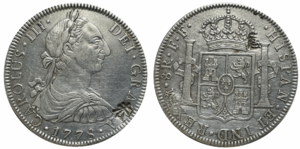
The Count of Campomanes suggested that the Jesuits were behind the riot. The Jesuits were a powerful and wealthy religious order. So, by a royal decree on February 27, 1767, the Jesuits were expelled from Spain and all its territories. Their possessions were taken by the state. This greatly impacted the colonies, where Jesuits ran schools and missions.
Charles also reduced the power of the Church in general. He reduced the number of clergy and limited the Spanish Inquisition. He also removed old laws that restricted trade and industry. He built roads, canals, and drainage systems. While some of his projects wasted money, overall, Spain prospered under his rule. He worked steadily at governing.
Charles also reformed colonial policy to make Spain's colonies more competitive. He created "Spanish Black Codes" to control slaves and expand farming in the colonies.
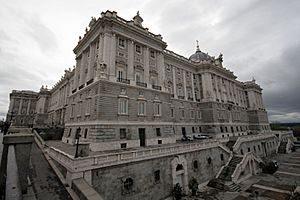
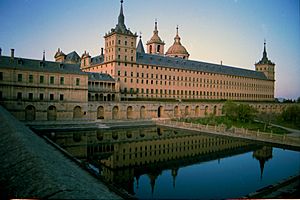
In Spain, he continued to improve services for his people. He created factories for luxury porcelain, crystal, and silver. During his reign, areas like Asturias and Catalonia became industrialized. He also encouraged trade with the United States starting in 1778. He built public works like the Imperial Canal of Aragon and new roads to Madrid. Other cities like Seville also saw improvements. In Madrid, he was nicknamed "the Best Mayor of Madrid." He granted the title "Royal University" to the University of Santo Tomás in Manila, the oldest in Asia.
In the capital, he built the famous Puerta de Alcalá and redesigned the Real Jardín Botánico de Madrid (Royal Botanical Garden). He had the current National Art Museum of Queen Sofia and the famous Museo del Prado built. He also added to the Aranjuez Palace.
He created the Spanish Lottery and introduced Christmas cribs. He also supported the creation of "Economic Societies," which were early forms of chambers of commerce.
The Royal Palace of Madrid was changed a lot under his rule. He died in the palace on December 14, 1788.
Ruling the Spanish Empire
The Spanish Empire was vast, covering much of America and the Philippines. Charles III ruled these territories.
Centralizing Power and Raising Money
Charles extended his policies of centralizing power to his overseas territories. This was especially true after the Seven Years' War, when the British captured Havana and Manila (1762–63). Charles's goal was to create a more unified empire. The Seven Years' War showed Charles that Spain's military was not strong enough against Britain. So, defending the empire became a top priority.
To raise money for the military, the sales tax was increased. To boost trade, Havana and other Caribbean ports were allowed to trade more freely within the Spanish empire. Spain hoped this would reduce Britain's secret trade with Spanish America and bring more money to the crown.
Charles sent José de Gálvez to New Spain (Mexico) in 1765. His job was to find ways to get more money from this rich colony and observe its conditions. Gálvez later became Minister of the Indies and made big changes. He replaced the old system with new administrative districts to strengthen the king's control.
Expulsion of the Jesuits (1767)
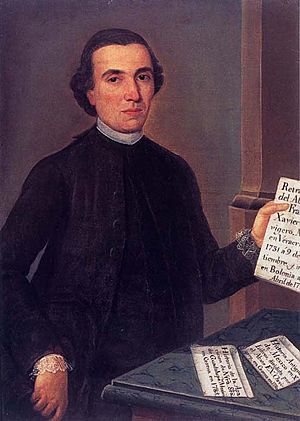
Charles's Italian minister, Esquilache, was not liked in Spain. People blamed him for policies they opposed. After riots in 1766, the Jesuits were seen as the real cause of the unrest. After exiling Esquilache, Charles expelled the Jesuits from Spain and its empire in 1767.
In Spanish America, this had a huge impact. The Jesuits were a wealthy and powerful religious group. They owned profitable farms and ran missions and schools. Suddenly, this important order was sent to Italy. Jesuit properties were taken, their schools closed, and missions were given to other religious groups. This was a big change for the empire.
Bourbon Reforms
The Spanish government introduced the Bourbon Reforms to make its colonial empire run better. In 1776, as part of these reforms, the Viceroyalty of the Río de la Plata was created. This separated parts of modern Bolivia and Argentina from the Viceroyalty of Peru. This meant that the economic benefits from the important silver mines at Potosí now went to Buenos Aires instead of Lima. This caused economic hardship in some areas.
In 1780, a large uprising of indigenous people happened in Peru, led by Túpac Amaru II. This rebellion was against the colonial rulers.
Personal Life
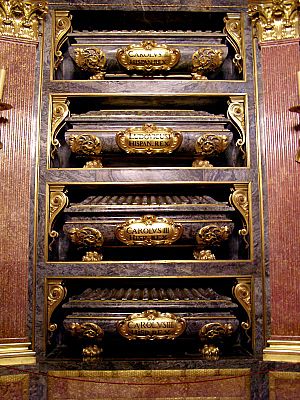
Charles had a strict and structured education. He was very religious and admired his strong mother. He was taught printmaking and painting. He also loved physical activities, especially hunting. A British diplomat noted how much Charles enjoyed hunting.
He had the distinctive "Bourbon nose" from his father's family. People described him as a "brown boy, who has a lean face with a bulging nose." He was known for being happy and lively.
His mother found him a wife, Maria Amalia of Saxony, from Poland. She was 13 when she learned of the marriage. They married by proxy in May 1738. This marriage helped end his disagreements with the Pope. They met for the first time on June 19, 1738. Charles created the Order of Saint Januarius to celebrate. Later, he created the Order of Charles III in Spain in 1771.
Charles's beloved wife, Maria Amalia, died unexpectedly in 1760 at age 35. She was buried at the El Escorial.
Charles was a regular and thoughtful person in his private life. He loved hunting. In his later years, he had some problems with his eldest son and daughter-in-law.
He was buried in the Pantheon of the Kings at the Royal Monastery of El Escorial.
Legacy
Charles III's rule is seen as a high point for the Spanish Empire. He became king of Spain with a lot of experience and made important changes to improve Spain's economy and strengthen its empire. He died in 1788, just months before the French Revolution began.
Charles III did not prepare his son and heir, Charles IV, well for ruling. Charles IV continued some of his father's policies. But he was later forced to give up his throne by his son, Ferdinand VII of Spain, and then imprisoned by Napoleon Bonaparte when France invaded Spain in 1808.
The coat of arms used by Charles as King of Spain was used until 1931. Felipe VI of Spain, Spain's current king, is a direct descendant of Charles III.
Charles III University of Madrid, founded in 1989, is named after him.
Images for kids
-
Statue of Charles III in Madrid
-
Statue of Charles III in Madrid (Juan Adsuara), 1966
-
Charles III, statue du Real Jardín Botánico de Madrid
Family
Children
| Name | Birth | Death | Notes |
|---|---|---|---|
| Princess Maria Isabel Antonietta de Padua Francisca Januaria Francisca de Paula Juana Nepomucena Josefina Onesifora of Naples and Sicily | Palace of Portici, Portici, Modern Italy, 6 September 1740 | Naples, 2 November 1742 | died in childhood. |
| Princess Maria Josefa Antonietta of Naples and Sicily | Palace of Portici, 20 January 1742 | Naples, 1 April 1742 | died in childhood. |
| Princess María Isabel Ana of Naples and Sicily | Palace of Capodimonte, 30 April 1743 | Palace of Capodimonte, 5 March 1749 | died in childhood. |
| Princess María Josefa Carmela of Naples and Sicily | Gaeta, Italy 6 July 1744 | Madrid, 8 December 1801 | unmarried |
| Princess Maria Luisa of Naples and Sicily | Palace of Portici, 24 November 1745 | Imperial Palace of the Hofburg, Vienna, 15 May 1792 | married the future Leopold II, Holy Roman Emperor in 1765 and had children. |
| Prince Felipe Antonio Genaro Pasquale Francesco de Paula of Naples and Sicily | Palace of Portici, 13 June 1747 | Palace of Portici, 19 September 1777 | Duke of Calabria; excluded from succession to the throne due to his developmental challenges. |
| Prince Carlos Antonio Pascual Francisco Javier Juan Nepomuceno Jose Januario Serafin Diego of Naples and Sicily | Palace of Portici, 11 November 1748 | Palazzo Barberini, Rome, 19 January 1819 | future King Charles IV of Spain; married Princess Maria Luisa of Parma and had children. |
| Princess Maria Teresa Antonieta Francisca Javier Francisca de Paula Serafina of Naples and Sicily | Royal Palace of Naples, 2 December 1749 | Palace of Portici, 2 May 1750 | died in childhood. |
| Prince Ferdinando Antonio Pasquale Giovanni Nepomuceno Serafino Gennaro Benedetto of Naples and Sicily | Naples, 12 January 1751 | Naples, 4 January 1825 | married twice; first married to Archduchess Maria Carolina of Austria and had children; the current line of the Two Sicilies descends from them. |
| Prince Gabriel Antonio Francisco Javier Juan Nepomuceno José Serafin Pascual Salvador of Naples and Sicily | Palace of Portici, 11 May 1752 | Casita del Infante, San Lorenzo de El Escorial, Spain, 23 November 1788 | married Infanta Mariana Vitória of Portugal, daughter of Maria I of Portugal; had three children, two of whom died young. |
| Princess Maria Ana of Naples and Sicily | Palace of Portici, 3 July 1754 | Palace of Capodimonte, 11 May 1755 | died in childhood. |
| Prince Antonio Pascual Francisco Javier Juan Nepomuceno Aniello Raimundo Sylvestre of Naples and Sicily | Caserta Palace, 31 December 1755 | 20 April 1817 | married his niece, Infanta Maria Amalia of Spain (1779–1798) in 1795 and had no children. |
| Prince Francisco Javier Antonio Pascual Bernardo Francisco de Paula Juan Nepomuceno Aniello Julian of Naples and Sicily | Caserta Palace, 15 February 1757 | Royal Palace of Aranjuez, Spain, 10 April 1771 | died 14 years old |
Heraldry
- Heraldry of Charles III of Spain
See also
 In Spanish: Carlos III de España para niños
In Spanish: Carlos III de España para niños



